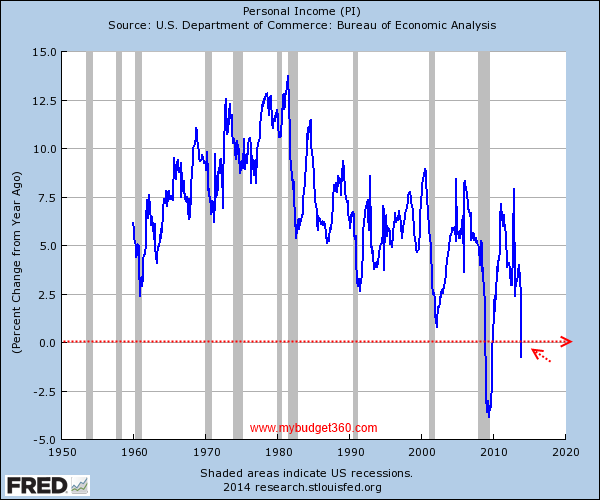Much like a perfect storm at sea is the consequence of three
converging bad weather fronts, three significant global economic trends
have begun to intensify and converge in recent months: (1) a slowing of
the China economy and a parallel growing financial instability in its
shadow banking system; (2) a collapse in emerging markets currencies
(India, Brazil, Turkey, South Africa, Indonesia, etc.) and their
economic slowdown; (3) a continued drift toward deflation in the
Eurozone economies, led by growing problems in Italy and economic
stagnation now spreading to France, the Eurozone’s second largest
economy. The problems in these three critical areas of the global
economy, moreover, have begun to feed off of each other.
Despite tens of trillions of dollars injected into the global economy since 2008 by central banks in the US, UK,
Europe,
and, most recently Japan, real job creating investment is slowing
everywhere globally. The massive liquidity (money) injections by central
banks have either flowed into global financial markets speculation
(stocks, bonds, derivatives, futures, options, foreign exchange, funds
and financial instruments of various kinds), hoarded as cash on bank and
non-bank corporate balance sheets, hidden away in dozens of offshore
tax shelters from Cayman islands to the Seychelles, or invested in
emerging markets like China, India, Brazil, Indonesia, Turkey, and
elsewhere.
The primary beneficiaries of these central bank money creation
policies have been global very high net worth investors, their financial
institutions, and global corporations in general. According to a study
in 2013 by Capgemini, a global business consultancy, Very High Net Worth
Investors increased their investable wealth by $4 trillion in 2012
alone, with projected further asset growth of $4 trillion a year in the
coming decade. The primary financial institutions which invest on their
behalf, what are called ‘shadow banks’ (i.e. hedge funds, private equity
firms, asset management companies, and dozens of other globally
unregulated financial institutions) more than doubled their total assets
from 2008 to 2013, and now hold more than $71 trillion in investible
assets globally.
This massive accrual of wealth by global finance capitalists and
their institutions occurred in speculating and investing in offshore
financial and emerging market opportunities—made possible in the final
analysis by the trillions of dollars, pounds, Euros, and Yen provided at
little or no cost by central banks’ policies since 2008. That is, until
2014.
That massive tens of trillions of dollars, diverted from the US,
Europe and Japan to the so-called ‘Emerging Markets’ and China is now beginning to flow back from the emerging markets to the ‘west’.
Consequently in turn, the locus of the global crisis that first erupted in 2008 in the U.S., then shifted to
Europe
between 2010-early 2013, is now shifting again, a third time. Financial
and economic instability is now emerging and deepening in offshore
markets and economies—and growing increasingly likely in China as well.
(The following analysis of China today is an excerpt from the
author’s forthcoming article “The Emerging Global Economic Perfect
Storm”, that will appear in the March print issue of ‘Z’ Magazine, where
the Eurozone and Emerging Markets’ economies are assessed as well. For
the complete article, see Z Magazine or the author’s website,www.kyklosproductions.com/articles/html.)
China’s Growing Financial and Economic Instability
Prior to the 2008 global financial crisis and recession, China’s
economy was growing at an annual rate of 14 percent. Today that rate is
7.5 percent, with the strong possibility of a still much slower rate of
growth in 2014.
China initially slowed economically in 2008 but quickly recovered and grew more rapidly by 2009—unlike the U.S. and
Europe.
A massive fiscal stimulus of about 15 percent of its GDP, or 3 times
the size of the comparable U.S. stimulus of 2009, was responsible for
China’s quick recovery. That fiscal stimulus focused on
government-direct investment in infrastructure, unlike the U.S. 2009
stimulus that largely focused on subsidies to states and tax cuts for
business and investors. In 2007-08 China also had no shadow banking
problem to speak of. So the expansionary monetary policies it
introduced, along with its stimulus, further aided its rapid recovery by
2010. Since 2012, however, China has been encountering a growing
problem with global shadow banks that have been destabilizing its
housing and local government debt markets. At the same time, beginning
in 2012, the China non-financial economy, including its manufacturing
and export sectors, has been showing distinct signs of slowing as well.
On the financial side, total debt (government and private) in China
has risen from 130 percent of GDP in 2008 to 230 percent of GDP, with
shadow banks share rising from 25 percent in 2008 to 90 percent of the
totals by 2013. So shadow banks share of total debt has almost
quadrupled and represents nearly all the debt as share of GDP increase
since 2008. Shadow banks have thus been the driving force behind China’s
growing local debt problem and emerging financial fragility.
Much of that debt increase has been directed into a local housing
bubble and an accompanying local government debt bubble, as local
governments have pushed housing, new enterprise lending, and local
infrastructure projects to the limit. Local government debt was
estimated in 2011 by China central government at $1.7 trillion. It has
grown in just 2 years to more than $5 trillion by some estimates. Much
of that debt is also short term. It is thus highly unstable, subject to
unpredictable defaults, and could spread and destabilize a broader
segment of the financial system in China—much like subprime mortgages
did in the U.S. before.
A run-up in private sector debt is now approaching critical
proportions in China. A major global instability event could easily
erupt there, in the event of a default of a bank or a financial product.
In some ways, China’s situation today increasingly appears like the
U.S. housing and U.S. state and local government debt markets circa
2006. China may, in other words, be approaching its own Lehman Moment.
That, in fact, almost occurred a few months ago with financial trusts in
China. Fearing a potential default by the China Credit Trust, and its
spread, investors were bailed out at the last moment by China central
government. According to the Wall St. Journal, the event “exposes the
weakness of the shadow banking system that has sprung up since 2009.
Growing financial instability in China in its local markets is thus a
major potential problem for China, and for the global economy as well,
as both China and the world economy begin to slow in 2014.
Early in 2013, China policymakers recognized the growing problem of
shadow banks and bubbles in its local housing and investment markets.
Speculators had driven housing prices up by more than 20 percent in its
major cities by 2013, from a more or less stable 3-5 percent annual
housing market inflation rate in 2010. China leaders therefore attempted
to rein in the shadow banks in May-June 2013 by reducing credit
throughout the economy. But that provoked a serious slowdown of the rest
of the economy in the spring of 2013. Politicians then returned on the
money spigot quickly again by summer 2013 and added another mini-fiscal
stimulus package to boost the faltering economy. That stimulus targeted
government spending on transport infrastructure, on reducing costs of
exports for businesses, and reducing taxes for smaller businesses. The
economy recovered in the second half of 2013.
By early 2014, the housing bubble has again appeared to gather steam,
while the real economy shows signs once again of slowing as well. In
early 2014 it appears once again that China policymakers intend to go
after its shadow bank-housing bubble this spring 2014. That will most
likely mean another policy-initiated slowing of the China economy, as
occurred in the spring of 2013 a year earlier. But that’s not all.
Overlaid on the financial instability, and the economic slowdown that
confronting that instability will provoke, are a number of other factors
contributing to still further slowing of the China economy in 2014.
Apart from the economy’s recent fiscal stimulus and its overheated
housing markets, China’s other major source of economic growth is its
manufacturing sector, and manufacturing exports in particular. And that,
too, is slowing. The reasons for the slowing in manufacturing and
exports lie in both internal developments within the Chinese economy as
well as problems growing in the Euro and Emerging market economies.
China is experiencing rising wages and a worsening exchange rate for
its currency, the Yuan. Both are raising its manufacturing costs of
production and in turn making its exports less competitive. Rising costs
of production are even leading to an exodus of global multinational
corporations from China, headed for even cheaper cost economies like
Vietnam, Thailand, and elsewhere.
The majority of China’s exports go to
Europe
and to emerging markets, not just to the U.S. And as emerging market
economies slow, their demand for China manufactured goods and exports
declines. Conversely, as China itself slows economically, it reduces its
imports of commodities, semi-finished goods, and raw materials from the
emerging market world (as well as from key markets like
Australia and Korea).
Similar trade-related effects exist between China and the Eurozone.
China in fact is Germany’s largest source for its exports, larger even
than German exports to the rest of
Europe. So if China slows, it will require fewer exports from
Europe, which will slow the already stagnant Eurozone economies even further. Similarly, as
Europe
stagnates, it means less demand for China goods—and thus a further
slowing of China’s manufacturing. In other words, China’s internal
slowdown will exacerbate stagnation and deflation in
Europe, as well as contribute to an even faster economic slowing now underway in the emerging market world.
Slowing will result as well from government policies designed to
structurally shift the economy to a more consumption driven focus. That
shift to consumption will begin in earnest following the Community
Party’s March 2014 meeting. But consumption in China represents only 35%
percent of the economy (unlike 70 percent in the U.S.), while China
government investment is well over 40 percent of GDP. And it is not
likely that consumption can grow faster enough to offset the reduction
in investment, at least not initially.
So a long list of imminent major developments and trends in China
point to a slowing of growth in that key global economy of almost $10
trillion a year. What happens in China, the second largest economy in
the world, has and will continue to have a major negative impact on an
already slowing Emerging Markets and a chronically stagnant Eurozone.
How the U.S. economy responds to the emerging global perfect storm
will prove interesting, to say the least. But with evidence of US
slowing in housing, manufacturing, job creation, auto and other retail
sales, and with real family median income in decline and the real
likelihood of further spikes in food and gasoline prices in the months
immediately ahead, the ‘perfect storm’ emerging offshore do not portend
well for the still fragile US economy now in its fifth year of below
average, ‘stop-go’ economic recovery.
Jack Rasmus is the author of the book, ‘Obama’s
Economy: Recovery for the Few’, Pluto press, 2012 and ‘Epic Recession:
Prelude to Global Depression’, Pluto, 2010. He is the host of the weekly
radio show, ‘Alternative Visions’, on the Progressive Radio Network.
His website is www.kyklosproductions.com, his blog, jackrasmus.com, and twitter handle, @drjackrasmus.






 People around the world often complain about the “
People around the world often complain about the “


